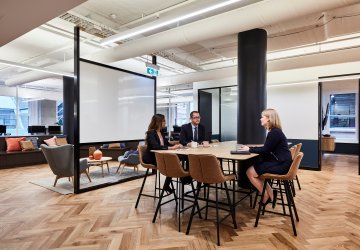Everybody uses the spaces around them. In our professional and private lives, we are constant consumers of the services and facilities offered when working at the office, buying clothes at a shopping center, or going through an airport on a business trip. However, sometimes we can be unaware of the effort it takes behind the scenes to ensure these spaces and facilities provide users with the best experience.
Creating the best experience is the goal of property and asset owners. For example, consumers are spending more per visit in-store than they would online because of the emotional ambiance. At airports, poorly maintained terminals are not only unappealing, but can further stress passengers already nervous about flying. And as we have discussed in the past, employees are more productive in appealing work environments. Offices become social meeting places that should inspire creativity and the COVID pandemic has made the concept of “office quality” even more relevant.
The services that contribute to a pleasant experience
Some of the services that contribute to a pleasant experience are very visible to consumers: a friendly welcome at a reception desk, delicious lunch options, or modern restroom facilities. These are the “soft services” facility management service providers deliver to property owners and occupiers. There are many more services that are not as visible but have an equally large influence on the experience of consumers. Many things in everyday life are taken for granted - having power, or hot water - but it requires effective monitoring and maintenance to keep these utilities running. These services are named “hard services.” Many property owners outsource soft and hard FM services to commercial service providers to allow them to be more cost-effective and to focus on their core business.
These examples show the challenging relationships between the various parties involved and the different requirements and expectations around properties, assets and services:
- Property and facility management service providers: Providers of soft and/or hard services manage and maintain properties and assets to unburden property owners (customers). Their primary goal is providing these services in an efficient and cost-effective way to gain and retain customers.
- Building or property owners: The owners of properties or assets, such as large corporations, government organizations or universities. Their primary goal is to offer a location that supports their business objectives, whether that is retail sales, student study spaces, or corporate offices that enhance the brand image.
- Building occupiers, end-users, consumers: The population using the facilities and services offered by building or property owners. Their primary goal is a seamless experience that supports them in their particular activity.
This series of interconnected relationships is referred to as the B2B2C-model, in which commercial service providers extend their existing “business to business” (B2B) relationship with contract managers to also include the end users and “consumers” of the service (B2B2C). It gets even more complex to deliver services when including lessees of a property or sub-contractors of a service provider.
Why it matters
According to research commissioned by Planon and conducted by Verdantix, 60% of companies rate occupant (the consumer) satisfaction with facilities as influential when determining their outsourcing strategy. Yet many Integrated Facility Management service providers struggle with how to balance the conflicting values of their paying customer with those of the ultimate end user.
For example, an escalator at an airport might require some planned maintenance. The airport is motivated to have the maintenance done before the escalator breaks and causes a long-term issue. However, travelers will be frustrated by being redirected in the short term. A service provider can advise that the work be performed during non-peak hours to reduce disruption.
In another example, the current trend for increased working from home, triggered by the COVID-19 pandemic, means a company may be interested in reducing office space to lower its property-related costs. However, if this change is not managed properly, employees working in the office then start to feel uncomfortable, productivity will go down and employee retention becomes an issue. This is a perfect example of when service providers can play the role of strategic partner. They can advise clients about options that address both the company goals and end-user requirements. That might be through activity-based workspaces, engaging employees in the space redesign process, or using feedback buttons to gather feedback on new workspaces.

